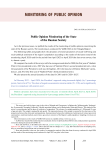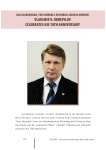Economic and Social Changes: Facts, Trends, Forecast @volnc-esc-en
Статьи журнала - Economic and Social Changes: Facts, Trends, Forecast
Все статьи: 1728
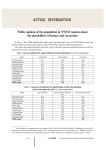
Public opinion of the population in NWFD regions about the possibilities of leisure and recreation
Статья обзорная
Бесплатно
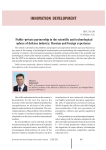
Статья научная
The article is devoted to the problems and prospects of cooperation between state and business as key areas in the strategy of technological modernization and maintaining the competitiveness of the economy. It analyzes the international experience of public-private partnership in the scientific and technological content of the military economy. The analysis held in the course of research has proved that the PPP in the defensive industrial complex of the Russian Federation is the best and often the only possible perspective of the further innovative development of the industry.
Бесплатно
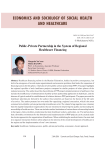
Public-private partnership in the system of regional healthcare financing
Статья научная
Healthcare financing reform in the Russian Federation, besides its positive consequences, has led to the emergence of several major organizational and economic problems that hinder the expansion of financing sources for this sphere, which also involves public-private partnership (PPP). The paper highlights the regional specifics of such healthcare projects compared to similar projects of other spheres of the national economy. The author describes the problems of PPP projects implementation in healthcare; they include the insufficiency of substantiation of public-private partnership application in healthcare, and the absence of typical models for establishment of relations between PPP participants. The paper presents the healthcare priorities put forward by the author; these priorities are based on the theory of the life cycle of a service. The author presents her own model for organizing a regional concession, which is the most common form of public-private partnership in healthcare so far...
Бесплатно
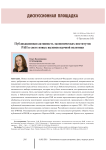
Publishing activity of RAS economic institutes amid new challenges of science policy
Статья научная
New challenges of science policy in Russia have determined a number of objectives which require scientific institutions to implement specific solutions aimed at improving research quality and efficiency. Since the evaluation of research results requires the use of different metrics, including bibliometrics, the main issue lies in the choice of indicators which can be used to conduct multi-analysis. The aim of this study is to implement the holistic approach to bibliometric assessment of scientific institutions and to analyze the performance of academic activity of economic institutions on the basis of the proposed criteria. The article summarizes the results of scientometric indicators monitoring, conducted at the Institute of Socio-Economic Development of Territories of the Russian Academy of Sciences. The analysis is based on a large set of publications of academic economic institutions for the period 2011-2015. The informational basis of the research includes data of the Russian Science Citation Index (RSCI)...
Бесплатно
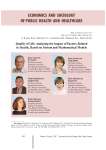
Статья научная
The paper considers the formation of the structure of the indicator of the quality of health as a major factor that has the greatest impact on the quality of life. The paper also analyzes the properties of the proposed structure and main approaches to assessing and measuring the quality of life and quality of health. It is established that the integral indicator of health quality has a complex structure that belongs to the class of hierarchical structures. The paper studies properties of hierarchical structures with the help of systematic approach, according to which the integral indicator of health quality was broken down and three components (system indicators) were identified. They are as follows: quality of care, quality of environment and quality of health. Each component, in turn, was broken down and presented as a triad of interrelated objective and subjective indicators of lower level (partial indicators). The proposed system model for assessing the integral indicator of health quality is a spatial structure of this indicator, which takes into account the links between system indicators at the median level and the links between partial indicators at the lower level...
Бесплатно
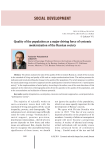
Quality of the population as a major driving force of systemic modernization of the Russian society
Статья научная
The article analyzes the state of the quality of life in modern Russia as a result of the increase in the standard of living and quality of life and as a major modernization factor. The author presents the indicators and trends describing the change in the quality of the population. The article proposes to combine the classical patronage (extensive) approach and the participatory (intensive) formation of a “participatory society” in the implementation of social policy. According to the author, one of the main directions of this approach is the redirection of demographic policy from the quantity to the quality of the population, and to the accumulation and realization of human potential.
Бесплатно
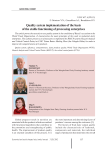
Quality system implementation of the basis of the stable functioning of processing enterprises
Статья научная
The article proves the necessity to use quality system in the conditions of Russia's accession to the World Trade Organization. It characterizes the main principles of this work in industrial dairy enterprises. The authors present a set of measures to implement the HACCP system (Hazard Analysis and Critical Control Points) at CJSC Totma Butter-Making Plant (the Vologda Oblast) in order to improve the competitiveness of its products.
Бесплатно

